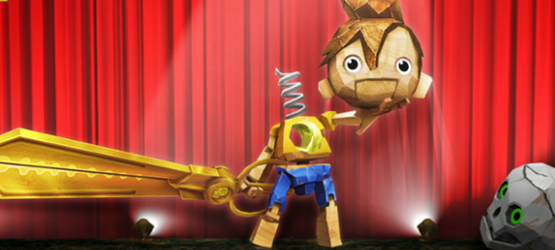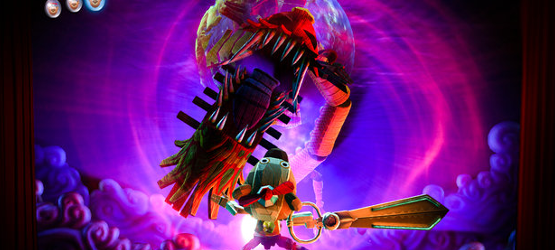
Have you ever seen a movie marketed at kids and found the visuals to be absolutely stunning? Not much else of the movie made sense, but the scene where the dude and the princess have their first dance across the rainbow straits is mind-numbingly gorgeous. Behold an accurate comparison for Puppeteer.
Puppeteer does try to aim for everyone. It may host an E10+ rating, but the story and characters are so rooted in traditional fairytales and mythology it would be easy to apply to any age. The game also takes cues from earlier platformers and adventure games. Imagine: LittleBigPlanet’s aesthetics, Zelda’s plot items, Mario’s platforming, and God of War’s boss finishers, all dancing on the same strings. And then there’s a lot more. The journey’s seven acts and 21 stages encompass a wide range of locations and situations.
Having written the above, the plot remains of the excuse variety. Protagonist Kutaro (pronounced every way from Cut-aro, Cut-taro to Cue-taro) is a young boy whose soul has been captured by the evil Moon Bear King, stuffed into a puppet, and then further traumatized by having his head ripped off and eaten by the villain. In order to return his soul to Earth, Kutaro must equip different heads and recover the 12 light moonstone pieces, revive the Moon Goddess, and defeat the Moon Bear King. Puppeteer’s basic plot is saved by its presentation.
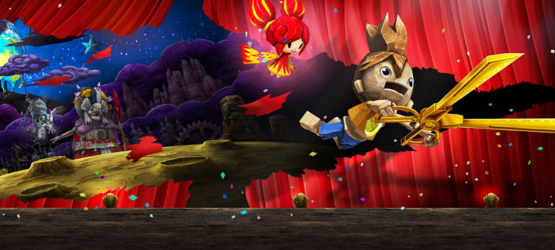
And what a presentation! All of the characters look as if they are stage-worthy puppets. The entire game is presented as a puppet show. The title screen is a curtain, and the narrator welcomes the player to the show. Pressing start and getting into the game continues the show. Level and scene changes are accomplished by removing set pieces and placing them, with sounds similar to the draws of a puppeteer’s case. When a particularly expressive or comedic bit occurs, the audience reacts with laughs or awe. There are an astronomical amount of things going on in the background, and the player can interact with the majority of these events or set pieces. The levels are very well done, and navigation is fairly easy. The graphics are suitably cartoony with no visible graphical tearing or glitches – in terms of looks, the game is fantastic.
The sound effects are on the same level as the presentation and graphics, and often fit just as perfectly. The music is good, but the tunes sound derivative. Many pieces had me humming other, similar tunes from various games or movies. Other than that, the soundtrack falls into immediate disregard, unremembered without a current listen.
Gameplay is pretty simple. Kutaro can run and jump over obstacles before attaining Calibrus, enchanted shears and one of the game’s literal vehicles. Unlike other games where the hero would blindly swing his huge blade in battle, Kutaro snips away at foes, or by removing fabric or seams from his puppet enemies. Kutaro also travels by snipping objects in the air or riding seams. Additionally, Kutaro gains access to bombs, a diving bash, and a grapple – all of which can be used on enemies and to maneuver or change the game’s levels. Kutaro can also switch out heads. Heads are initially ornamental, but the player will stumble upon places where a certain head must be equipped. If the right head is available, a bonus is awarded in the form of shards, bonus levels, or new heads. 100 shards will net players another life.
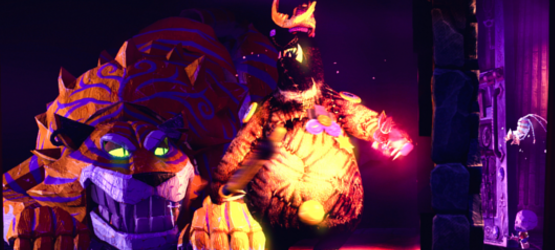
The game plays well, but at the same time the controls are nothing to write home about. Despite Kutaro’s tricks, the gameplay is relatively simple. The boss fights are based on patterns, and finishers use a quick time event system. However, the buttons for the events match the actions they are assigned: if Kutaro makes a jump during the QTE, players will press the jump button. This includes Kutaro’s other actions as well, like the smash and grapple. The QTE’s make a lot of sense.
The game is fairly easy. Just playing the game will give players enough lives to get through anything, and should Kutaro’s head get knocked off there’s a few seconds to retrieve it the head disappears. If Kutaro has no more heads in his inventory, he loses a life. Checkpoints are very common and players don’t have to traverse far to recover lost time. If there is challenge in the game, it’s undoubtedly mastering Pikarina at the same time as Kutaro. Pikarina interacts with the background using the right analog stick and the R2 button, and during some of the game’s faster moments players will have to be quick to both keep Kutaro alive and use Pikarina to get all the gems or unlock more secrets.
There is quite a bit to do in Puppeteer. All of the levels can be replayed at any time once a level is completed, which is necessary because some of the earlier levels require heads or special moves gathered in later levels. There is an extras section where players can view all of the available heads, backstories on characters gained by beating the seven Acts, and the ability to replay bonus stages. Beating the game keeps everything unlocked. The trophies are numerous and fairly easy to get.
Characterization ranges from inconsistent to terrible. In addition to Kutaro being a mute hero, the script is played mostly for humor and often breaks the fourth wall due to the narrator being another character in the story, so expecting a lot from the characters isn’t a priority. However, Pikirina, an incredibly annoying sprite, takes the proverbial cake. “Hey, Listen!” does not begin to describe the level of annoyance this character possesses. Her constant switching between adoring cute animals and wanting treats to badmouthing everything else is very grating. And she’s talking all the time. It’s not the voice, however patterned after the stereotype of the modern day idiot American teenager – it’s the actual things she says. Her comments are downright ignorant and borderline intolerant. I understand her purpose within the game, yet I shudder to think there might be a child out there who is going to emulate this damned brat. And let’s face it – this game has the cover and graphics a mother would love – the game is going to find its way to kid’s homes.
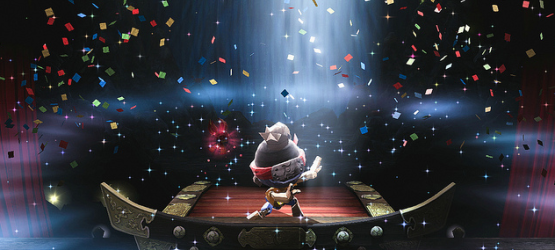
Pikarina’s personality is meant as a foil to the narrator, and he often counters back with logical arguments and decent wisdom to which the player should listen – the narrator’s advice may affect the current situation. The interplay between speaking characters is often fantastic, with puns and bad jokes flying about, greatly adding to the feel of Puppeteer as a puppet show. The many pronunciations of Kutaro’s name are a great example of these puns: He uses scissors, so Cut-Taro or Cut-aro works. Pikarina calls him Cue-Taro because she likes cute things. Taro is Japanese for ‘boy’ to further the punderful nature. When the dialogue clicks, it really clicks.
Despite the game’s age rating, I would encourage parents to watch their kids play or participate in the game itself. A second player can control Pikarina, picking up shards or helping to retrieve Kutaro’s heads. Most importantly, playing alongside their kids would give parents the ability to chime in about some of the things the different characters say, and maybe defray some of the ignorance Pikarina continually displays. Puppeteer does support the Move controller, so parents unfamiliar with gaming may have better luck with those controls.
Outside of its visuals, Puppeteer is a very standard platform title which manages to pull several different sources together well enough to play, but not good enough to pull a player from other titles. Puppeteer would be a great title to play in-between other games, and those who do play Puppeteer will be rewarded with a satisfactory experience when the credits finish rolling.
-
Your eyes are treated to awesome.
-
Dialogue can be great with lots of little puns and jokes.
-
An overall satisfactory experience.
-
Pikarina
